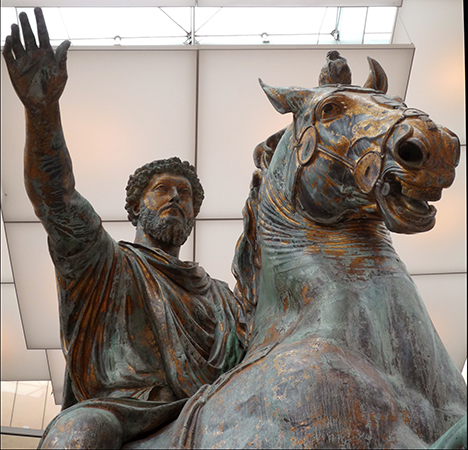Description
The horse
The emperor’s horse is a magnificent example of dynamism captured in the sculptural medium. The horse, caught in motion, raises its right foreleg at the knee while planting its left foreleg on the ground, its motion checked by the application of reins, which the emperor originally held in his left hand. The horse’s body—in particular its musculature—has been modeled very carefully by the artist, resulting in a powerful rendering. In keeping with the motion of the horse’s body, its head turns to its right, with its mouth opened slightly. The horse wears a harness, some elements of which have not survived. The horse is saddled with a Persian-style saddlecloth of several layers, as opposed to a rigid saddle. It should be noted that the horse is an important and expressive element of the overall composition.
The horseman
The horseman sits astride the steed, with his left hand guiding the reins and his right arm raised to shoulder level, the hand outstretched.
Portrait types
There are approximately 110 known portraits of Marcus Aurelius and these have been grouped into four typological groupings. The first two types belong to the emperor’s youth, before he assumed the duties of the principate.
The second portrait type was made when Marcus was in his late 20s, c. 147 C.E. and shows a still youthful type, although Marcus now has light facial hair (left).
This mature type (type III, left) shows the emperor fully bearded with a full head of tightly curled, voluminous hair; he retains the characteristic oval-shaped face and heavy eyelids from his earlier portraits. His coiffure forms a distinctive arc over his forehead. This third type is known from approximately 50 copies.
Dating of the Equestrian portrait
Interpretation and chronology
The pose of the horseman is also helpful. The emperor stretches his right hand outward, the palm facing toward the ground; a pose that could be interpreted as the posture of adlocutio, indicating that the emperor is about to speak. However, more likely in this case we may read it as the gesture of clemency (clementia), offered to a vanquished enemy, or of restitutio pacis, the “restoration of peace.” Richard Brilliant has noted that since the emperor appears in civic garb as opposed to the general’s armor, the overall impression of the statue is one of peace rather than of the immediate post-war celebration of military victory. Some art historians reconstruct a now-missing barbarian on the right side of the horse, as seen in a surviving panel relief sculpture that originally belonged to a now-lost triumphal arch dedicated to Marcus Aurelius (left). We know that Marcus Aurelius celebrated a triumph in 176 C.E. for his victories over German and Sarmatian tribes, leading some to suggest that year as the occasion for the creation of the equestrian monument.
History
In 1538 the statue was relocated from the Lateran quarter to the Capitoline Hill to become the centerpiece for Michelangelo’s new design for the Campidoglio (a piazza, or public square, at the top of the Capitoline hill). The statue was set atop a pedestal at the center of an intricately designed piazza flanked by three palazzi (image above). It became the centerpiece of the main piazza of secular Rome and, as such, an icon of the city, a role that its still retains. The equestrian statue still plays a role as an official symbol of the city of Rome, even being incorporated into the reverse image of the Italian version of the € 0.50 coin (image above). The statue itself remained where Michelangelo positioned it until it was moved indoors in 1981 for conservation reasons; a high-tech copy of the original was placed on the pedestal. The ancient statue is now housed within the Musei Capitolini where it can be visited and viewed today.
Candela Citations
- Middle Empire: Equestrian Sculpture of Marcus Aurelius. Authored by: Dr. Jeffrey A. Becker. Provided by: Khan Academy. Located at: https://www.khanacademy.org/humanities/ancient-art-civilizations/roman/middle-empire/a/equestrian-sculpture-of-marcus-aurelius. Project: Middle Empire: Equestrian Sculpture of Marcus Aurelius. License: CC BY-NC-SA: Attribution-NonCommercial-ShareAlike












